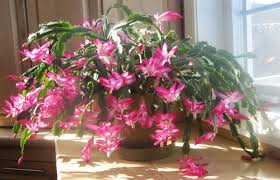One of my favorite houseplants at this time of year is holiday cactus. During November and December, these cacti are covered with long tubular blooms. Over the years, I have collected several plants, each with different colored blossoms, including white, pale pink, hot pink, red and salmon.
While I used to think that all of these plants were Christmas cacti, I recently learned that two types of holiday cacti bloom during November and December. The one that most stores sell is Schlumbergera truncate, the so-called Thanksgiving cactus that blooms around that holiday. The second type is Schlumbergerabridgesii, which blooms about one month later. That one is the true Christmas cactus.
The Thanksgiving cactus has flattened stem segments with saw tooth projections along the margins; the Christmas cactus has more rounded margins. In addition, the anthers of the Thanksgiving cactus are yellow, while the anthers on the Christmas cactus are purplish-brown.
These cacti are native to South America, growing in tropical jungles at altitudes ranging from 3,000 to 5,000 feet. They are epiphytes, meaning that they grow on objects or other plants. They obtain water and nutrients from the humid air around them instead of from the soil. When grown indoors, these cacti need bright but filtered light, so place them near a south-facing window. In warmer months, they can live outside in a sheltered shady place.
While these plants are easy to grow, it is sometimes a challenge to get them to bloom for the holidays. There are a few tricks to encouraging bloom.
Pinch back the stems in early June to encourage branching and more terminals for flowers. At the end of September, remove any end segments that are either damaged or less than a half-inch long. Flower buds will only form on undamaged, mature stem segments.
Holiday cacti set their flower buds when the days turn shorter and cooler. To create optimum blooming conditions, provide cool nighttime temperatures (50°F to 55°F) and 12 to 14 hours of darkness starting in mid-September. Street lights, car lights or indoor lighting can disrupt the required dark period, so place cacti where constant darkness is guaranteed. Reduce watering as growth slows. When flower buds appear, gradually increase watering and provide temperatures between 60°F and 65°F. Feed every other week during the bloom period with a fertilizer intended for houseplants.
While the plants are blooming, keep them away from drafty spots and heating or air conditioning vents. After blooming, the plants appreciate a rest period of six to eight weeks. Keep them cool (around 55°F) and water lightly until new spring growth appears. During the growing season,feed monthly with houseplant fertilizer diluted to half strength. Stop fertilizing in late summer to encourage fall flowering.
Holiday cacti like to be pot bound. Repot them about every three years in the spring. Choose a fast-draining mix containing 60 to 80 percent potting soil and 20 to 40 percent perlite. Allow the soil mixture to dry out partially before watering so air can circulate around the roots.
Propagate the cacti by taking cuttings in May or June. Select stems with three to five segments. Let cuttings dry in the shade for at least one day. Fill a clean four- to six-inch container with fresh potting soil. Insert three to five cuttings one inch deep into moistened soil.
Cover the plants and container with a clear plastic bag or other translucent material to create a mini greenhouse. Support the plastic so that it does not touch the cuttings. A clean, clear plastic soda bottle with the bottom removed works great as a covering. Place the covered container in bright, indirect light. In three to eight weeks, roots will form and you can remove the covering.
If your cactus isn't blooming by Christmas, all is not lost. Give it the daily darkness treatment for six to eight weeks, and you should have a flowering plant by early spring.
Workshop: U. C. Master Gardeners of Napa County will host a workshop on “Rose Pruning and Maintenance” on Saturday, January 9, from 10 a.m. to noon, at the University of California Cooperative Extension office, 1710 Soscol Avenue, Napa.This workshop will feature demonstrations of proper pruning techniques. Master Gardeners will discuss types of roses, common rose diseases and routine maintenance On-line registration (credit card only) coming soon. Mail-in registration (check only).
Master Gardeners are volunteers who help the University of California reach the gardening public with home gardening information. U. C. Master Gardeners of Napa County ( http://ucanr.org/ucmgnapa/) are available to answer gardening questions in person or by phone, Monday, Wednesday and Friday, 9 a.m. to Noon, at the U. C. Cooperative Extension office, 1710 Soscol Avenue, Suite 4, Napa, 707-253-4143, or from outside City of Napa toll-free at 877-279-3065. Or e-mail your garden questions by following the guidelines on our web site. Click on Napa, then on Have Garden Questions? Find us on Facebook under UC Master Gardeners of Napa County.
